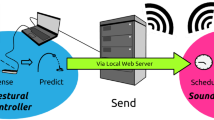Abstract
This article is motivated by the question “Can a sonification system that provides continuous auditory heart rate feedback help stabilize an athlete’s heart rate at a given target heart rate while exercising?” The sonification system uses a Polar H7 heart rate sensor to measure the heart rate of the athlete and an iOS device for its processing and display. We implemented several sonification approaches, of which two were tested in both a unimodal and an audiovisual context in comparison to a purely visual feedback and to not having any feedback. The system’s objective performance and multiple subjective usability aspects were evaluated in an experiment with 16 subjects. The experiment has to be considered a pilot study because the exercising conditions were artificial. The subjects were exercising on an indoor cycle and could focus their visual sense on the visual display all the time. It was found that all of the feedback methods could convey information to the athlete and were therefore clearly superior to not having any feedback. The failure of showing a supremacy of the multimodal methods over the purely visual one can be reasoned by the fact that the testing conditions were artificial and could therefore not show the advantages of auditory/audiovisual feedback due to limited bandwidth of the visual channel. The conclusions we make about the design and evaluation of such sonification systems can be considered a useful starting point for further work in this field.












Similar content being viewed by others
References
Barrass S, Best V (2008) Stream-based sonification diagrams. In: Proceedings of the 14th international conference on auditory display, pp 1–6
Burke E (1998) Precision heart rate training. Human Kinetics, Champaign
Godbout A, Thornton C, Boyd J (2014) Mobile sonification for athletes:a case study in commercialization of sonification. In: Proceedings of the 20th international conference on auditory display, pp 1–8
Hasegawa H (2010) A real time feedback and monitoring of speed and power in resistance training for athletes. In: 7th international congress on strength training, pp 51–54
Hollander M, Wolfe D (1999) Nonparametric statistical methods, 2nd edn. Wiley series in probability and statistics: texts and references section. Wiley, Hoboken
Karvonen J, Vuorimaa T (1988) Heart rate and exercise intensity during sports activities. Sports Med 5:303–311. doi:10.2165/00007256-198805050-00002
Kenney W, Humphrey R, Mahler D, Bryant C (1995) ACSM’s Guidelines for exercise testing and prescription. Williams & Wilkins, Philadelphia
Kislenko K, Grevholm B (2008) The likert scale used in research on affect—a short discussion of terminology and appropriate analysing methods. Presented at the 11th International Congress on Mathematical Education, “tsg.icme11.org/document/get/415” . Online; accessed 07 Apr 2016
Likert R (1932) A technique for the measurement of attitudes. Arch Psychol 140:5–55
Malliani A, Lombardi F, Pagani M (1994) Power spectrum analysis of heart rate variability: a tool to explore neural regulatory mechanisms. Br Heart J 71:1–2. doi:10.1136/hrt.71.1.1
Mihalas G, Popescu L, Naaji A, Andor M, Paralescu S, Tudor A, Neagu A (2015) Adding sound to medical data representation. In: Proceedings of the 21st international conference on auditory display, pp 325–326
Orzessek B, Falkner M (2006) Sonification of autonomic rhythms in the frequency spectrum of heart rate variability. In: Proceedings of the 12th international conference on auditory display, pp 272–274
Polar Electro (2016) Polar Sport Zones \(|\) Polar Global. http://www.polar.com/en/support/tips/Polar_Sport_Zones/. Online accessed 05 Jan 2016
Robergs R, Landwehr R (2002) The surprising history of the ’hrmax=220-age’ equation. J Exerc Physiol 5:1–10
Schaffert N, Mattes K, Barrass S, Effenberg A (2009) Exploring function and aesthetics in sonifications for elite sports. In: Proceedings of the 2nd international conference on music communication science (ICoMCS2), pp 83–86
Schaffert N, Mattes K, Effenberg A (2011) Examining effects of acoustic feedback on perception and modification of movement patterns in on-water rowing training. In: Audio mostly conference: a conference on interaction with sound, pp 122–129. doi:10.1145/2095667.2095685
Wärnegård H (2012) Heart rate sonification-using sound to monitor heart rate when running. Course report, KTH Royal Institute of Technology Stockholm
Yu B, Feijs L, Funk M, Hu J (2015) Designing auditory display of heart rate variability in biofeedback context. In: Proceedings of the 21st international conference on auditory display, pp 294–298
Acknowledgments
We would like to acknowledge the contribution of Norberto Degara and Nadja Schinkel-Bielefeld for the statistical analysis part and David Worrall for his input on the pitch mapping scheme.
Author information
Authors and Affiliations
Corresponding author
Additional information
This was a research project at Fraunhofer Institute of Integrated Circuits, Erlangen, Germany.
Rights and permissions
About this article
Cite this article
Stahl, B., Thoshkahna, B. Design and evaluation of the effectiveness of a sonification technique for real time heart-rate data. J Multimodal User Interfaces 10, 207–219 (2016). https://doi.org/10.1007/s12193-016-0218-7
Received:
Accepted:
Published:
Issue Date:
DOI: https://doi.org/10.1007/s12193-016-0218-7




